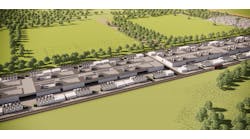Sophie Vorrath, editor of One Step off the Grid, reports on a Western Australia microgrid plan expected to save the government hundreds of millions of dollars in infrastructure costs.
Western Australia’s Labor Party has announced plans to both build and install 1,000 standalone power systems – or SAPS – including solar, battery storage and hydrogen electrolysers across its grid over the coming five years, as part of a $259 million policy package to boost green manufacturing in the state.
The new policy package, which will also put $10 million towards local wind turbine manufacturing, was announced by the McGowan government on Wednesday, after it scrambled to deal with the Liberal Opposition’s refreshingly ambitious New Energy Jobs plan that includes a zero emissions grid by 2030.
Of the $259 million earmarked, the vast majority will go towards the creation and rollout of the 1,000 SAPS, an increasingly popular solution to remote and regional power supply that is already somewhat of a specialty of Western Australia’s government-owned network companies.
“The commitment of more than 1,000 standalone power systems will create a baseline demand for locally manufactured power systems, including solar panels, batteries and hydrogen electrolysers – driving hundreds of local manufacturing jobs and putting WA at the forefront of high-tech industries,” the government said in a statement.
The ambitious program, which has been declared a Strategic Project under the WA Jobs Act to ensure local manufacturers are part of the deal – will be delivered by state government-owned network companies Horizon Power and Western Power.
(A separate energy industry development team will also be established, to work with local renewable energy manufacturers and the mining industry to accelerate the transition to renewables on remote mine sites.)
As noted above, both companies are already highly supportive of the use of stand-alone solar and battery-backed power systems – in 2019, Western Power described them as the front-runner technology to transform power reliability for rural WA.
“Longer-term, we estimate SPS technology could save the WA government hundreds of millions in infrastructure costs in costly upgrades of poles and wires for end of the line customers,” said then SPS program manager Margot Hammond.
Beyond cost, Western Power, whose grid spans from Kalgoorlie in the east to Perth in the west, and Albany in the south, to Kalbarri in the north, has also demonstrated that SAPS can, on average, deliver a 15-fold reliability improvement for fringe-of-grid customers.
Since a pilot program in 2016, Western Power has gone on to install 57 stand-alone power systems in 2019 and is currently rolling out 100 more – a combination of solar PV and battery technology with a backup diesel generator – in the Mid-West, Goldfields, eastern Wheatbelt and Great Southern regions.
Horizon Power also kicked off its SAPS journey in 2016, when it installed five stand-alone solar and storage systems at farms in Esperance, after bush fires destroyed more than 320 power poles and hundreds of kilometers of power lines on the network in November 2015.
That experiment was a success, and the following year Horizon decided to take more of its remote regional customers off grid as a cheaper and more reliable alternative to traditional poles and wires and a cleaner and more secure back-up option than diesel fuel-powered generators.
All of that said, the production and roll-out of 1000 SAPS over five years is a huge gearing-up of the state’s shift to a grid powered by distributed and remote off-grid renewables.
In the past, Western Power has partnered with various local and interstate renewable energy companies on the rollout of SAPS on its network, including Perth-based Hybrid Systems, which supplied, delivered and installed 49 out of 57 of the SAPS installed in 2019.
Exactly where the government plans to install the 1,000 SAPS remains to be seen, although the statement said some would go to remote Aboriginal communities, to reduce their reliance on diesel, stabilize networks, and support local jobs.
“These sensible and practical initiatives will help our state become greener and cleaner, while creating jobs for Western Australians,” said premier Mark McGowan on Wednesday.
“This is another important step in our plan to invest in a low carbon future while creating job opportunities, developing new industries and working with all sectors to achieve net zero emissions for WA by 2050.
“We are using the strengths of our existing industries to diversify the economy into new and sustainable job creating industries, in a responsible, achievable and affordable way,” McGowan said.
“To support our renewables future, my Government has enabled TAFE to deliver the courses required for the future skills needed in the renewable energy and hydrogen sectors, and made it cheaper to obtain a qualification.”
This article originated on One Step Off the Grid and was reposted with permission.






